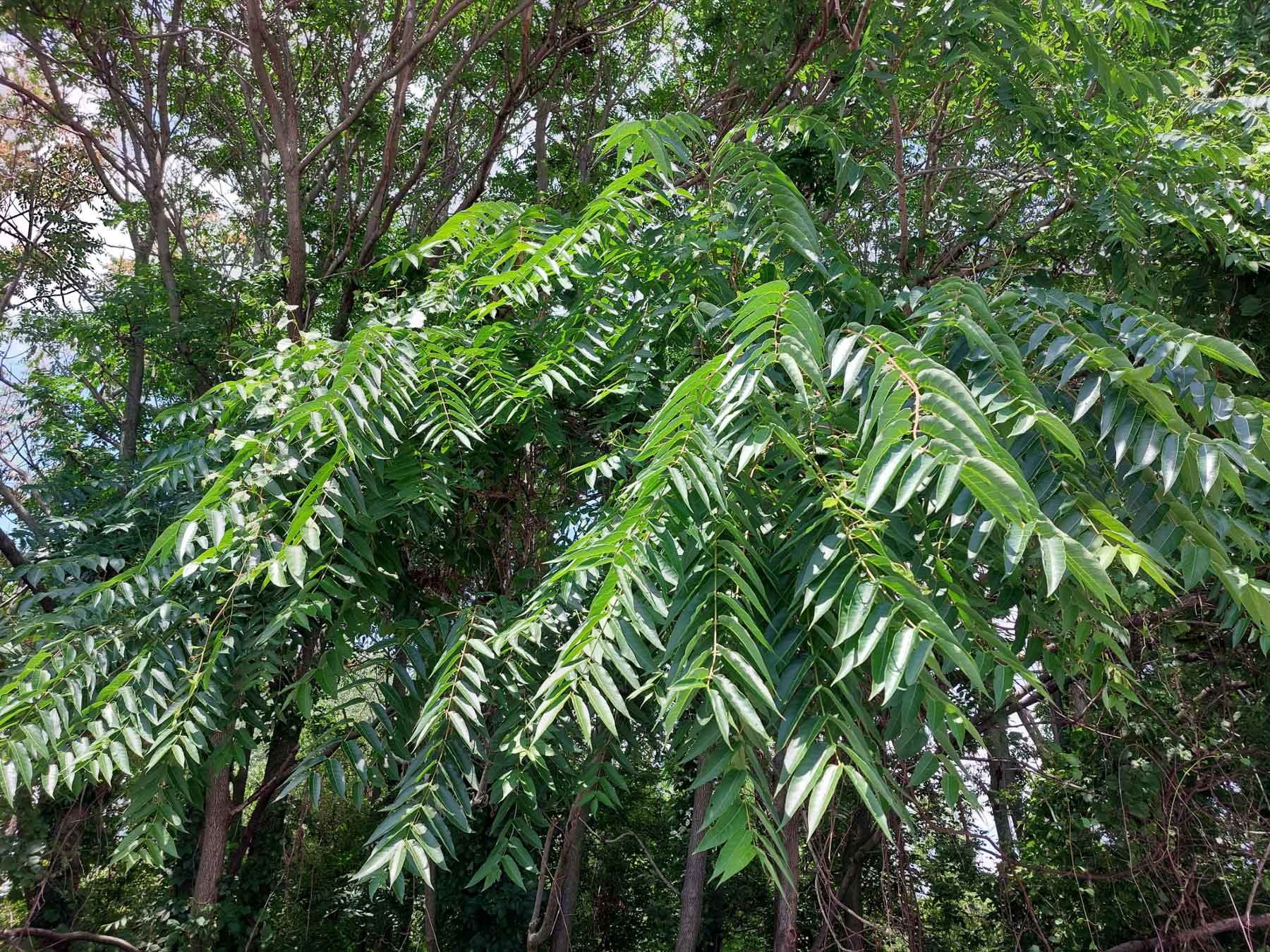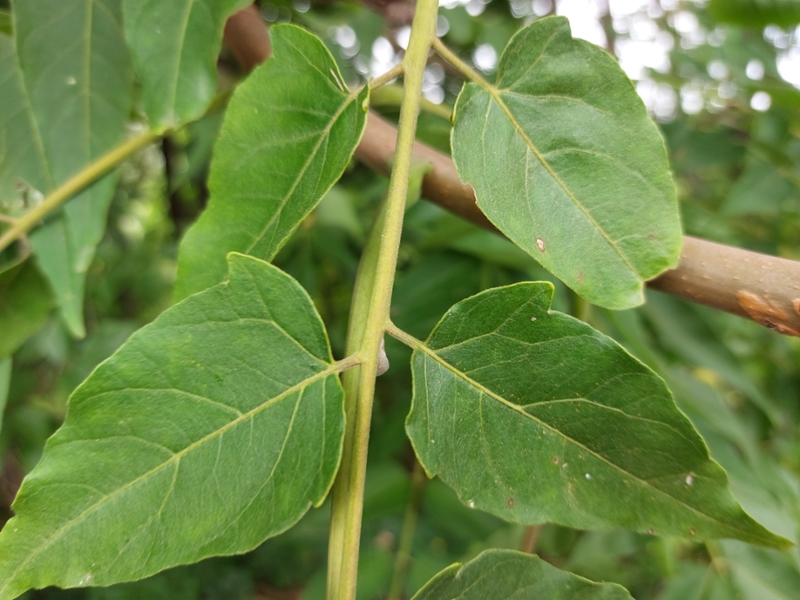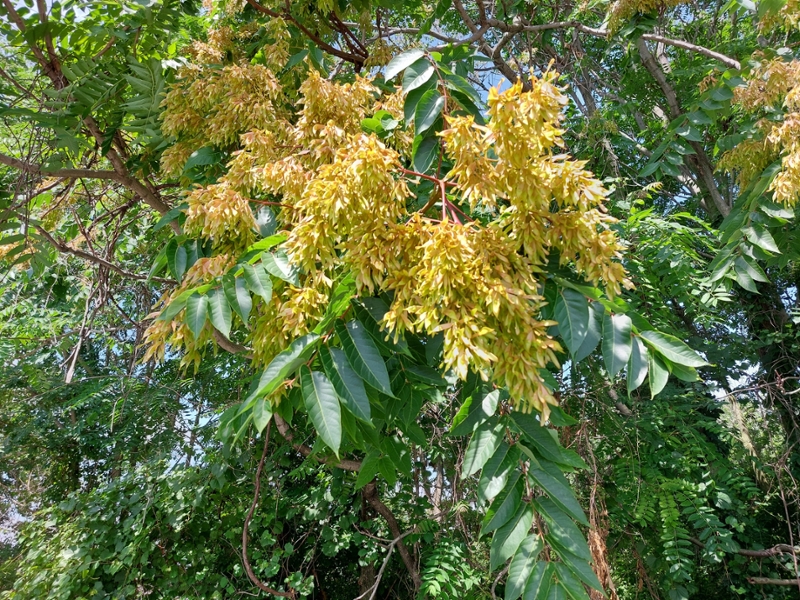Above: photo by John E. Woodmansee
At first glance, you might think that a tree so named would be great to consider for a home landscape. The resounding answer to that consideration is “NO.” As you read on, I’ll give you some reasons why.
According to the EDD MapS website (https://www.eddmaps.org/), tree-of-heaven (Ailanthus altissima) is a rapidly growing, typically small deciduous tree up to 80 ft. (24.4 m) in height and 6 ft. (1.8 m) in diameter. It has large, heart-shaped leaf scars on the twigs. The bark is smooth with lenticels and light grey, developing fissures as it grows older. Leaves and other plant parts smell like rancid peanut butter.
At first glance, the compound leaves (See Figure 1) look somewhat like black walnut, but they typically have more leaflets (11-41) than black walnut (15-23). Tree-of-heaven’s leaf, comprised of many leaflets, can be up to 2½ feet long, while black walnut’s leaf may reach a maximum of 2 feet. Tree-of-heaven leaflets have what we call “glandular teeth” (See Figure 2) at the base of an otherwise nearly smooth or entire leaf margin. Tree-of-heaven will have a single terminal leaflet, while most black walnut leaves have two leaflets at the tip. If in doubt, give leaves a smell test as previously described. (Leaflet numbers from 101 Trees of Indiana, by Marion T. Jackson). The leaves could also be confused with some sumac species.
So, why is this tree a bad idea, and why are efforts being taken to reduce natural populations?
First of all, it is an invasive species. It is identified as such in Indiana’s Terrestrial Plant Rule (effective in 2019), which makes it illegal to sell, gift, barter, exchange, distribute, transport, or introduce these plants in the State of Indiana. For more information, visit https://www.in.gov/dnr/rules-and-regulations/invasive-species/terrestrial-invasive-species-plants/.
Over time, you wouldn’t like it if you had it. A Purdue expert explains why.
“Despite its sublime name, tree-of-heaven, Ailanthus altissima, is a particularly bad actor when is comes to trees encountered in the Midwest,” wrote Purdue Extension forester, Lenny Farlee, recently. “This native of Asia was introduced to North America more than 150 years ago and has since become a widespread invasive pest.”
“Rapid growth, extremely high seed production (hundreds of thousands from a mature female tree; See Figures 3 and 4), and root sprouting that can turn one tree into dozens makes this a formidable competitor with our native plants,” he said. “Tree-of-heaven can sprout and grow almost anywhere, including cracks in streets and sidewalks or building foundations, resulting in infrastructure damage and increased costs of maintenance.”
In addition to its invasive nature, tree-of-heaven serves as the preferred host for a new invasive insect in Indiana, the spotted lanternfly. In 2022, this insect was confirmed in Huntington, IN. Due to its excellent ability to hitchhike on any vehicle (trains, it seems, in particular), this insect could be anywhere in Indiana. And, when it finds tree-of-heaven along these travel corridors, it also finds a preferred food source.
So, despite the heavenly name, tree-of-heaven is one to avoid and eradicate, if possible.
To read Farlee’s original article, which includes control strategies, go to https://www.purduelandscapereport.org/issue/23-12/.

Figure 1: Tree-of-heaven leaf; Photo: John Woodmansee

Figure 2: Tree-of-heaven glandular teeth at base of leaflets; Photo: John Woodmansee

Figure 3: Tree-of-heaven seed clusters; Photo: John Woodmansee

Figure 4: Tree-of-heaven female with seed (left), and male (right); Photo: John Woodmansee